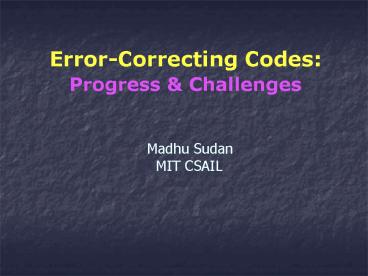Simple PCPs - PowerPoint PPT Presentation
Title:
Simple PCPs
Description:
Error-Correcting Codes: Progress & Challenges Madhu Sudan MIT CSAIL Communication in presence of noise Shannon s Model: Probabilistic Noise Hamming Model: Worst ... – PowerPoint PPT presentation
Number of Views:114
Avg rating:3.0/5.0
Title: Simple PCPs
1
Error-Correcting Codes Progress Challenges
Madhu Sudan MIT CSAIL
2
Communication in presence of noise
We are now ready
We are not ready
Noisy Channel
Sender
Receiver
If information is digital, reliability is critical
3
Shannons Model Probabilistic Noise
Sender
Receiver
Encode (expand)
Decode (compress?)
Noisy Channel
Probabilistic Noise E.g., every letter flipped
to random other letter of w.p. p Focus
Design good Encode/Decode algorithms.
4
Hamming Model Worst-case error
- Errors Upto worst-case errors
- Focus Code
- (Note Not encoding/decoding)
- Goal Design code so as to correct any pattern of
- errors.
5
Problems in Coding Theory, Broadly
- Combinatorics Design best possible
error-correcting codes. - Probability/Algorithms Design algorithms
correcting random/worst-case errors.
6
Part I (of III) Combinatorial Results
7
Hamming Notions
- Hamming Distance
- Distance of Code
- Main question
- Asymptotically
8
Simple results
- Ball
- Volume of Ball
- Entropy function
- Hamming (Packing) Bound
- (No code can have too many codewords)
9
Simple results (contd.)
- Gilbert-Varshamov (Greedy) Bound
10
Simple results (Summary)
- For the best code
- After fifty years of research We still dont
know.
Which is right?
11
Binary case
- Case of large distance
- Case of small (relative) distance
- Case of constant distance
BCH
12
Binary case (Closer look)
- For general
- Can we do better? Twice as many codewords?
- (wont change asymptotics of )
- Recent progress Jiang-Vardy
13
Proof idea of Jiang-Vardy
14
Major questions in binary codes
- Give explicit construction meeting GV bound.
- Is Hamming tight when
- Is LP Bound tight?
15
Combinatorics (contd.) q-ary case
- Fix
- Surprising result (80s)
- (Also a negative surprise BCH codes only yield
-
)
Plotkin
GV bound
Not Hamming
16
Major questions q-ary case
17
Part II (of III) Correcting Random Errors
18
Recall Shannon
19
Constructive versions
20
What is satisfaction?
- Articulated by Luby,Mitzenmacher,Shokrollahi,Spie
lman 96
21
Current state of the art
- Luby et al. Propose study of codes based on
irregular graphs (Irregular LDPC Codes).
22
LDPC Codes
23
LDPC Codes
24
Current state of the art
- Luby et al. Propose study of codes based on
irregular graphs (Irregular LDPC Codes). - No theorems so far for erroneous channels.
- Strong analysis for (much) simpler case of
erasure channels (symbols are erased) decoding
time - (Easy to get composition based algorithms
with - decoding time )
- Do have some proposals for errors as well (with
analysis by Luby et al., Richardson Urbanke),
but none known to converge to Shannon limit.
25
Still open
- Articulated by Luby,Mitzenmacher,Shokrollahi,Spie
lman 96
26
Part III Correcting Adversarial Errors
27
Motivation
- As notions of communication/storage get more
complex, modeling error as oblivious (to
message/encoding/decoding) may be too simplistic. - Need more general models of error
encoding/decoding for such models. - Most pessimistic model errors are worst-case.
28
Gap between worst-case random errors
- In Shannon model, with binary channel
- Can correct upto 50 (random) errors.
- In Hamming model, for binary channel
- Code with more than n codewords has distance at
most 50. - So it corrects at most 25 worst-case errors.
- Need new approaches to bridge gap.
29
Approach List-decoding
- Main reason for gap between Shannon Hamming
The insistence on uniquely recovering message. - List-decoding Relaxed notion of recovery from
error. Decoder produces small list (of L)
codewords, such that it includes message. - Code is (p,L) list-decodable if it corrects p
fraction error with lists of size L.
30
List-decoding
- Main reason for gap between Shannon Hamming
The insistence on uniquely recovering message. - List-decoding Elias 57, Wozencraft 58
Relaxed notion of recovery from error. Decoder
produces small list (of L) codewords, such that
it includes message. - Code is (p,L) list-decodable if it corrects p
fraction error with lists of size L.
31
What to do with list?
- Probabilistic error List has size one w.p.
nearly 1 - General channel Need side information of only
O(log n) bits to disambiguate Guruswami 03 - (Altly if sender and receiver share O(log n)
bits, then they can disambiguate Langberg 04). - Computationally bounded error
- Model introduced by Lipton, Ding Gopalan L.
- List-decoding results can be extended (assuming
PKI and some memory at sender) Micali et al.
32
List-decoding State of the art
- Zyablov-Pinsker/Blinovskii late 80s
- Matches Shannons converse perfectly! (So cant
do better even for random error!) - But ZP/B non-constructive!
33
Algorithms for List-decoding
- Not examined till 88.
- First results Goldreich-Levin for Hadamard
codes (non-trivial in their setting). - More recent work
- S.96, Shokrollahi-Wasserman 98,
Guruswami-S.99, Parvaresh-Vardy 05,
Guruswami-Rudra 06 Decode algebraic codes. - Guruswami-Indyk 00-02 Decode
graph-theoretic codes. - TaShma-Zuckerman 02, Trevisan 03 Propose
new codes for list-decoding.
34
Results in List-decoding
- Q-ary case
- Binary case
35
Few lines about Guruswami-Rudra
- Code Collated Reed-Solomon Code Concatenation.
36
Few lines about Guruswami-Rudra
- Special properties
- Is this code combinatorially good?
- Algorithmically good!! (uses ideas from
S96,GS98,PV05 new ones. - Can concatenate to reduce alphabet size.
37
Few lines about Guruswami-Rudra
- Warnings K, N, partition all very special.
Encoding \\ \indent First partition \F_q into
\red special sets S_0,S_1,\ldots,S_N,
\\ \indent \indent with S_1 \cdots S_N
C. \\ \indent Say S_1 \\alpha_1,\ldots,\alpha
_C\, S_2 \\alpha_C1,\ldots,\alpha_2C\
etc.\\ \indent Encoding of P\\ \indent \indent
\langle \langle P(x_1),\ldots,P(x_C)
\rangle, \langle P(x_C1),\ldots,P(x_2C)
\rangle \cdots \rangle
38
Major open question
39
Conclusions
- Many mysteries in combinatorial setting.
- Significant progress in algorithmic setting, but
many important open questions as well.
40
LDPC Codes
41
LDPC Codes































